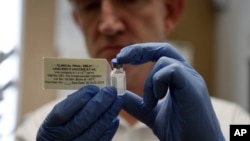Health workers in West Africa are still struggling to get suspected Ebola patients to come forward and go into isolation at treatment units, or ETUs, so they won’t infect others.
It has been a hard sell, in part because those ETUs can’t actually offer much in the way of treatment.
There is currently no cure for Ebola. Clinics in West Africa can give supportive care like rehydration therapy to help the patient’s body fight off the virus. But Ebola kills between 50 percent and 80 percent of those infected.
However, that picture could be improving.
In December, scientists will begin testing three possible treatments for Ebola at clinics in Guinea and Liberia run by Medecins Sans Frontieres, or Doctors Without Borders. They will be testing two antiviral drugs as well as a treatment using the blood and plasma of Ebola survivors whose antibodies may help other patients fight off the virus.
MSF says these trials are “accelerated” and mark “unprecedented international” collaboration.
Still, Annick Antierens, MSF deputy medical director, cautioned against expecting a miracle cure just yet. She said any treatment would be more effective when given early, before the virus spreads everywhere in the body, but not all patients come in during the first 48 hours. These trials, however, are just the beginning, and Antierens said there were other drugs they could test. People evacuated and treated in the U.S. and Europe have been getting combinations of treatments, so that’s an option as well.
Looking ahead
New Ebola cases are being reported every day in West Africa. This epidemic is far from over. Still, thoughts are already turning to the future, to the next outbreak.
There is talk of ramped-up surveillance and the creation of rapid response units that could go into the bush at the first signs. The World Health Organization has called for the development of a rapid diagnostic tool, a simple test that could give results in 30 minutes without need of a lab.
Liberia’s assistant health minister, Tolbert Nyensuah, said that "unless we can get a vaccine to immunize people against the disease and eradicate the disease, it will be a disease that will always come back, because we have the history in other countries in East Africa.”
The Democratic Republic of Congo just beat its seventh Ebola outbreak since the disease was first discovered there in 1976. Uganda has had five outbreaks since 2000.
In West Africa this year, Ebola spread in a way never before seen, on a scale never before seen. The virus reached urban areas, like Monrovia. It traveled by plane to the U.S. and Europe, sparking global alarm.
That alarm and the epidemic in West Africa spurred on what had been stalled research efforts.
Doing 'the impossible'
Dr. Myron Levine of the Center for Vaccine Development at the University of Maryland is working on a vaccine trial in Mali. He said it typically takes about a decade get a vaccine tested and licensed for general use, but this is uncharted territory.
“We’ve already kind of done the impossible," he said. "Lots of folks said there is no way we could go from a vaccine in August that had never been in a human being and complete dose-response phase 1 [trials] in West Africans within a few months. They said it was impossible. Well, impossible, you can cross out that word. It’s been done.”
Researchers have finished injecting the last of 91 Malian health workers with a test vaccine against the Zaire strain of the virus. The 91 volunteers were given varying doses and are being monitored. Their immune responses will "peak" in 28 days after the injection. Results are expected at the end of December.
If all goes well, a larger trial testing the efficacy of the vaccine is expected to start as soon as the first quarter of 2015.







